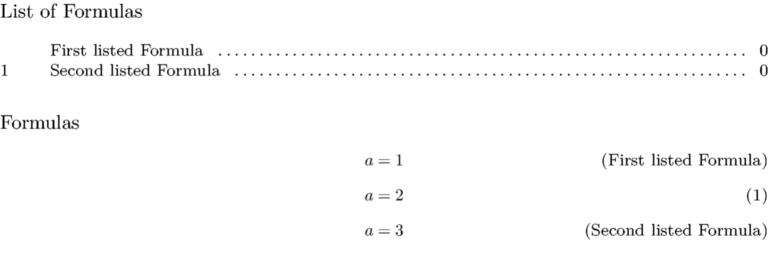Math/Display
< Math|
Contents
Display Math
Display math is enclosed in a \startformula / \stopformula pair. Thus
The famous result (once more) is given by \startformula c^2 = a^2 + b^2. \stopformula |
This, when typeset, produces the following:
|
Numbering Formulae
ConTeXt provides an easy way to number the display maths equations. Simply, put \placeformula before \startformula / \stopformula pair and you will get numbered equations. Thus,
The famous result (once more) is given by \placeformula \startformula c^2 = a^2 + b^2. \stopformula |
This, when typeset, produces the following:
|
The \placeformula command is optional, and produces the equation number; leaving it off produces an unnumbered equation.
Changing format of numbers
You can use \setupformulas to change the format of numbers. For example to get bold numbers inside square brackets use
\setupformulas[left={[},right={]},numberstyle=bold] |
which gives
|
To get alphabets instead of numbers, use
\setupformulas[conversion=Character] |
which gives
|
Referencing formulae
Equations can be referred to by simply adding a label to \placeformula and using \ref to create the reference:
The famous result (and again) is given by \placeformula[formulalabel] \startformula c^2 = a^2 + b^2. \stopformula And now we can refer to formula \ref[formulalabel]. |
This, when typeset, produces the following:
|
By default, only the formula number appears as a reference. This can be changed by using \definereferenceformat. For example, to create a command \eqref which shows the formula number in brackets, use
\definereferenceformat[eqref][left=(,right=)]
See References for more examples of \definereferenceformat.
Sub-Formula Numbering
As mentioned above, formulas can be numbered using the \placeformula command. This (and the related \placesubformula command have an optional argument which can be used to produce sub-formula numbering. For example:
Examples: \placeformula{a} \startformula c^2 = a^2 + b^2 \stopformula \placesubformula{b} \startformula c^2 = a^2 + b^2 \stopformula |
|
What's going on here is simpler than it might appear at first glance. Both \placeformula and \placesubformula produce equation numbers with the optional tag added at the end; the sole difference is that the former increments the equation number first, while the latter does not (and thus can be used for the second and subsequent formulas that use the same formula number but presumably have different tags).
This is sufficient for cases where the standard ConTeXt equation numbers suffice, and where only one equation number is needed per formula. However, there are many cases where this is insufficient, and \placeformula defines \formulanumber and \subformulanumber commands, which provide hooks to allow the use of ConTeXt-managed formula numbers with plain TeX equation numbering. These, when used within a formula, simply return the formula number in properly formatted form, as can be seen in this simple example with plain TeX's \eqno. Note that the optional tag is inherited from \placeformula.
More examples: \placeformula{c} \startformula \let\doplaceformulanumber\empty c^2 = a^2 + b^2 \eqno{\formulanumber} \stopformula |
|
In order for this to work properly, we need to turn off ConTeXt's automatic formula number placement; thus the \let command to empty \doplaceformulanumber, which must be placed after the start of the formula. In many practical examples, however, this is not necessary; ConTeXt redefines \displaylines and \eqalignno to do this automatically.
For more control over sub-formula numbering, \formulanumber and \subformulanumber have an optional argument parallel to that of \placeformula, as demonstrated in this use of plain TeX's \eqalignno, which places multiple equation numbers within one formula.
Yet more examples: \placeformula \startformula \eqalignno{c^2 &= a^2 + b^2 &\formulanumber{a} \cr c &= \left(a^2 + b^2\right)^{\vfrac{1}{2}} &\subformulanumber{b}\cr a^2 + b^2 &= c^2 &\subformulanumber{c} \cr d^2 &= e^2 &\formulanumber\cr} \stopformula |
|
Note that both \formulanumber and \subformulanumber can be used within the same formula, and the formula number is incremented as expected. Also, if an optional argument is specified in both \placefigure and \formulanumber, the latter takes precedence.
More examples for left-located equation number: \setupformulas[location=left] \placeformula{d} \startformula \let\doplaceformulanumber\empty c^2 = a^2 + b^2 \leqno{\formulanumber} \stopformula and \placeformula \startformula \leqalignno{c^2 &= a^2 + b^2 &\formulanumber{a} \cr a^2 + b^2 &= c^2 &\subformulanumber{b} \cr d^2 &= e^2 &\formulanumber\cr} \stopformula |
|
-- 23:46, 15 Aug 2005 (CEST) Prinse Wang
If you want named subformula with a reference see the solution proposed by Aditya Mahajan on the mailing-list [1] (2006-10-29). This feature should be added to the core eventually.
List of Formulas
You can have a list of the formulas contained in a document by using \placenamedformula instead of \placeformula. Only the formulas written with \placenamedformula are not put in the list, so that you can control precisely the content of the list.
\placenamedformula takes as first parameter the name of the formula put in the list. The other \placeformula features are still available. The list can be formatted like any other list.
Example:
\subsubject{List of Formulas} \placelist[formula][criterium=text,alternative=c] \subsubject{Formulas} \placenamedformula[one]{First listed Formula} \startformula a = 1 \stopformula \endgraf \placeformula \startformula a = 2 \stopformula \endgraf \placenamedformula{Second listed Formula}{b} \startformula a = 3 \stopformula \endgraf
Gives:









